|
Navigation on the Grand River
The Grand River Navigation system
began full operation in 1835. In all the Company had built five locks and
five dams, with three more locks and a dam at Brantford to be completed in
1848. Local resources of timber, gravel and stone were used in the
construction. Built to last, the lock walls were about six feet thick at
the base and five feet at the top.
In 1834, S.H. Farnsworth and Jacob
Turner were advertising: "two to three hundred steady labouring men will
find constant employment on the Grand River Canal. To carpenters and
masons as well as common labourers, industrious and faithful workmen,
liberal wages will be given through the season, either by the day, month
or job. No spirituous liquors will be allowed on or near the work." Soon
quantities of timber, barley, wheat, liquor and salt pork were making
their way down the river.
The great timber rafts played a
vital role in the economic life of the river. Timber intended for European
markets was piled at riverside mills during the winter and at spring
freshet time rafted downstream, pike-poled and prodded or pulled by
donkeys, oxen or horses walking along the bank.
By 1846 there were 566 scows and
barges passing through the Grand River Canal. The tugboats, Jessie
and Swallow, often pulled, pushed or nudged the flat-bottomed,
wide-waisted unattractive scows along the waterway. In addition to the
scows, 312 steamboats passed through the locks. The passenger steamships
Brantford and the Caroline Messmore cruised the river with
high-pressure steam engines producing a speed of 5 knots. Ranald McKinnon,
in one of his letters, said, "Neither of these boats have the speed
necessary to make them useful here." Seven years later this traffic had
more than doubled.
However, the belles of the Grand
River were the schooners, the full-skirted and proud vessels of their
time. After the Brantford cut was opened in
1848, a line of
sailing ships operated on a regular basis. The Tuscarora, Onondaga
and Mohawk graced the river as they passed downstream in
succession, bound from one inland port to another.
While in its prime, this period of
navigation was probably the most colourful portion of the history of the
Grand River. Passenger boats, like the well-known Red Jacket
steamship, and the monarch of them all, The Queen, were small
replicas of the Mississippi stern wheelers. The Queen, registered
in 1851, carried about 40 passengers and boasted two good staterooms and
excellent meals. It is said the crew consisted of a master, a mate, one
engineer, two firemen, two wheelmen, two deck hands, a cook, steward,
stewardess and purser.
By 1849 extensive profits allowed an
increase in the capital stock of the Company. However, by 1853 a report
confirmed that the emergence of railway lines would likely lead to the
less bulky items being gradually drawn away from the boats. Indeed, during
the period from 1854-60, an aura of doom was falling on the navigation
company. By April 1871, it had passed out of existence and was sold to the
Haldimand Navigation Company, who abandoned all the dams except the one at
York. Only the freight boats Caledonia and Port Dover were
still in service until the early 1860ís.
The collapse of the Grand River
Navigation Company meant that huge sums of money were lost, including a
considerable amount which had been invested by the Receiver General of
Canada on behalf of the Six Nations Indians. Thus a portion of the money
credited to them when the government took over the Grand River Grant in
1832 was gone forever.
Indiana, situated between York and
Cayuga, became a ghost town. By 1851 its founder, David Thompson (Member
of Parliament from 1841-1851), had died and the demise of the Grand River
Navigation Company sent inhabitants to other villages. David Thompsonís
large mansion "Ruthven", constructed in 1845, was all that was left of
Indiana by the turn of the century. Ruthven and its in excess of 1,200
acre estate remained in the family until the fifth generation. David
Thompson died in August, 1993. Today, the estate is attracting wide
interest as the Lower Grand River Trust Foundation and the Ruthven
Management Committee develops and restores Ruthven Park, as a living
memorial to David Thompson and his family for their contribution to
settlement in Haldimand County.
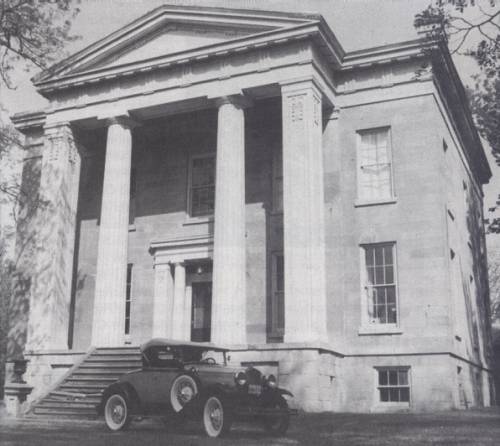
Ruthven Mansion sits on a 1,600-acre estate known as
Ruthven Park on Highway 54 between York and Cayuga, not far from
Caledonia. It was acquired by the Lower Grand River Land Trust Foundation
in May 1994 to be developed and preserved as a memorial to the Thompson
family. The mansion was begun in 1844 by David Thompson (1793-1851) during
the heyday of the Grand River Navigation System. John Latchaw of Niagara
was hired as the architect. Ruthven is one of the best examples of Greek
Classical Revivalist architecture in North America. Since it was built it
has been owned by the Thompson family: David Thompsonís son David, until
1886; Colonel Andrew Thompson, until 1939; Andrew Thompsonís grandsons,
Andrew (1992) and David, until his death in 1993. Ruthven is undergoing
extensive renovations in preparation for public viewing.
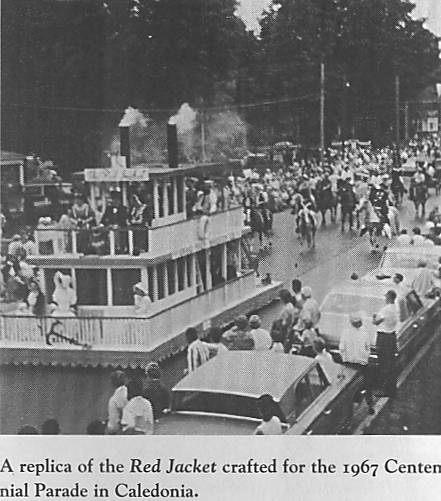 In
February 1994, the Grand River was designated as a Canadian Heritage
River. It is considered one of the oldest rivers in Ontario with its
outstanding geology resulting from landforms created by the last
glaciation 12,000 years ago. The Grand River flows through more than 60
municipalities in the most densely populated part of Canada. It is 290
kilometres long from its mouth at Port Maitland to its source in Dufferin
County. The heritage designation includes its four major tributaries, the
Nith, Conestoga, Speed and Eramosa. In
February 1994, the Grand River was designated as a Canadian Heritage
River. It is considered one of the oldest rivers in Ontario with its
outstanding geology resulting from landforms created by the last
glaciation 12,000 years ago. The Grand River flows through more than 60
municipalities in the most densely populated part of Canada. It is 290
kilometres long from its mouth at Port Maitland to its source in Dufferin
County. The heritage designation includes its four major tributaries, the
Nith, Conestoga, Speed and Eramosa.
The Grand Riverís industrial
heritage is recognized for its outstanding human heritage resources. The
strong association of Native Peoples with the watershed for thousands of
years is also represented in the formal designation. Grand River
communities like Caledonia are committed to ensuring that heritage and
recreational resources are maintained and enhanced for future generations.
Transportation on the Rails
For Caledonia, the advent of the
railroad meant the beginning of the end for navigation on the Grand River.
This first railway known as the Buffalo, Brantford and Goderich, linked
Buffalo on the Niagara River to Caledonia. The Paris Junction and the
Great Western Railway continued the line connecting Caledonia to Goderich
on Lake Huron.
 When
this Buffalo to Lake Huron railway went through Caledonia in 1852, the
communityís steady population growth came to a halt. Equal numbers of
people moving in and out of town stabilized the population at 1,250 until
1881. Then the population began to decline until it reached its lowest
level of 801 in 1901. However, by 1941, Caledonia had regained its
population and was once again a thriving community consisting of 1401
people. When
this Buffalo to Lake Huron railway went through Caledonia in 1852, the
communityís steady population growth came to a halt. Equal numbers of
people moving in and out of town stabilized the population at 1,250 until
1881. Then the population began to decline until it reached its lowest
level of 801 in 1901. However, by 1941, Caledonia had regained its
population and was once again a thriving community consisting of 1401
people.
The mid-nineteenth century was a
time of new development. Despite a fire which destroyed the best of the
business section in 1862,
private enterprise continued to invest and rebuild
businesses despite the fact that the debt load to the town council of
$40,000 for the building of the Hamilton Port Dover line delayed much
needed sidewalks and services.
During the 1860ís and 1870ís,
factories such as Ranald McKinnonís woollen factory (built in 1863), the
Scott Foundry, and Shoots and Avery Carriage Shop (manufacturers of
wagons, buggies and fancy horse vehicles) were doing big business. For a
time, Caledonia became the centre of an extensive square timber and sawed
lumber trade, much of which was shipped by barge along the Grand River
waterway. However, as the vast timber resources diminished, the lumber
trade gradually tapered off. Now that much of the land had been cleared,
farming began to appear more attractive to settlers.
Although it took some time for
manufacturing and agriculture to switch over to rail travel, there was a
gradual transition during the 50ís. The river was still being used in the
early 1870ís to transport gypsum from York to Caledonia, where it was
hauled by team and wagon to the train station and shipped by rail to Paris
for processing. In March 1866 a petition was passed by the village council
so that all day express trains were ordered to stop in Caledonia. This
increase in rail service made it
more convenient for Simcoe and Port Dover people to use
the trains rather than the Grand River Navigation system.
The townís people and businesses
were anticipating great things with the construction of the new Hamilton
Port Dover line. Of course, in the end, this was illusionary because it
not only took twenty years, from 1854ó1878 to complete, but it never
became the great railway divisional point as promised. The canal system on
the Great Lakes was being constantly improved and additional railroads
were being built from Western Ontario to the level of Lake Ontario.
By 1863, the town had sunk $40,000
into the venture and Hamilton had committed $500,000 more. The rail bed
had been graded and was ready for ties and rails from Hamilton to
Caledonia, but the need for more money brought construction to a
standstill. In addition to the delays, the huge cost had halted, to the
dismay of many, other much needed public works in the community.
Finally, in
1873 the line was
completed. The wooden railroad bridge across the Grand River had been
built at last. On June 30th, amid much celebration, the wood-burning John
Scott locomotive, from the local foundry, pulled the first express train
through to Jarvis. Mr. McLean was the watchman on this wooden bridge. He
would make an inspection walk across the length of the structure after
each train passed over. Barrels of water were placed along the bridge as a
safety precaution against fire. This bridge was replaced in 1886 with a
solid deck reconstruction.
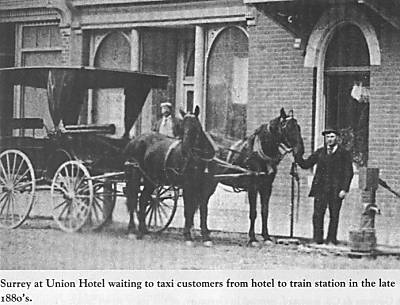 With the
railroad came a flurry of activity. The Campbell House Hotel was built
near the railroad tracks on the site where a Tim Hortons stands today:
this structure would burn down in 1931. Increased passengers meant
increased business for many including livery stables. Often a fine team of
black horses pulling a surrey would be seen taxiing rail passengers from
the station to the downtown Union Hotel. With the
railroad came a flurry of activity. The Campbell House Hotel was built
near the railroad tracks on the site where a Tim Hortons stands today:
this structure would burn down in 1931. Increased passengers meant
increased business for many including livery stables. Often a fine team of
black horses pulling a surrey would be seen taxiing rail passengers from
the station to the downtown Union Hotel.
Did this rail line live up to its
projected affect on the growth of Caledonia? Certainly the canal system on
the Great Lakes was improved and additional railroads were built. Yet the
heavy debt and the holding back of public works in Caledonia was
problematic. The Hamilton to Port Dover line was blamed for any village
misfortune although its real affect did not become evident until years
later. It was claimed that if the Hamilton line had not gone through
Caledonia, the village might have declined to the same level of
insignificance of other villages that no longer exist today.
Why was Caledonia different from
most Ontario villages that showed an increase of population in the years
following the advent of railroads? The advent of the railroad did not add
to the prosperity of Caledonia as largely as was anticipated. The railway
drew business from the Grand River Navigation Company which had worked up
a great and thriving business. The railroad destroyed the villageís
comparative position of being situated on one of the only good inland
water systems in Southwestern Ontario.
Despite the consequences of
competition between the river and rail industries, over the years the
train made many major contributions to the community, in time earning a
special place in the hearts of Caledonians. Jessie MacGregorís Concert
Bureau certainly made use of the rail service to transport her entourage
of entertainers to centres all over Ontario. Deals were made with
Passenger Associations for the Old Boys and Old Girls Reunion in 1927.
Reduced fares were arranged on the train from all points in Canada where
fares were more than 75 cents. A certificate would entitle all passengers
to return at one-half regular fare. If tickets couldnít be procured to
Caledonia from agents, passengers were told to get a ticket to Hamilton
and transfer from there to Caledonia. However, special fares were not
available to those coming from the United States.
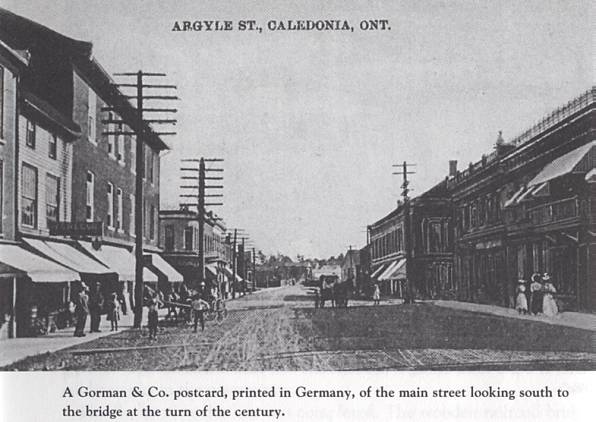
 Thousands
came to Caledoniaís Fair every year taking the train from Hamilton. "When
the Fairís midway came into town on the train, it was taken by team and
wagon to the fairgrounds. There were weigh scales on the Dennis Kelly
farm, now known as the Bob Thompson farm, where farmers would bring their
stock to be weighed and transferred into the nearby stockyard in readiness
for shipment by rail to Hamilton. Dennis Kelly was a buyer for the Kohler
Bros. of Cayuga in the 1930ís and 40ís. On a Monday morning one would see
twenty teams of horses and wagons at the weigh scales waiting for the
train. Thousands
came to Caledoniaís Fair every year taking the train from Hamilton. "When
the Fairís midway came into town on the train, it was taken by team and
wagon to the fairgrounds. There were weigh scales on the Dennis Kelly
farm, now known as the Bob Thompson farm, where farmers would bring their
stock to be weighed and transferred into the nearby stockyard in readiness
for shipment by rail to Hamilton. Dennis Kelly was a buyer for the Kohler
Bros. of Cayuga in the 1930ís and 40ís. On a Monday morning one would see
twenty teams of horses and wagons at the weigh scales waiting for the
train.
Entertainment for young children in
the 1920ís was sitting by the railroad track to watch the trains go by.
They were coming and going constantly during those years. However, the
days when you might see six big steam engines go through on a Sunday
afternoon were gone by the 1950ís.
Today trains entering Caledonia are
from Brantford. There is none that goes east beyond the town. When a train
arrives in town these days, residents listen for how long and hard its
whistle blows. The three short runs a day, from Brantford to Caledonia and
crossing the railway bridge enroute to Nanticoke, keep the train whistle
alive in Caledonia.
The Caledonia station, built in
1913, was closed as a parcel depot in November, 1977. Until its total
closure in 1982, it was used for a maintenance and storage depot. Although
the building had been approved for demolition it remained standing and was
used as a tool house. Today it is boarded up. There is active community
interest in having the station designated as a heritage building, restored
and put to good use as a tourist information centre.
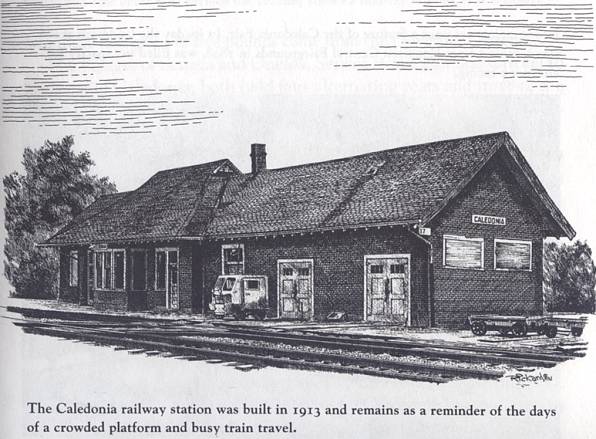 |
